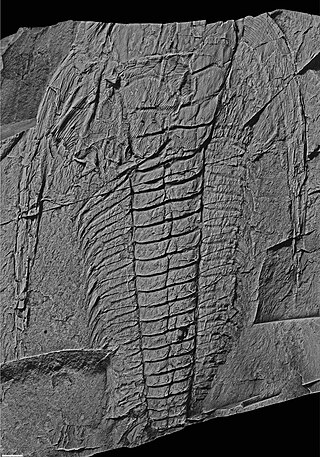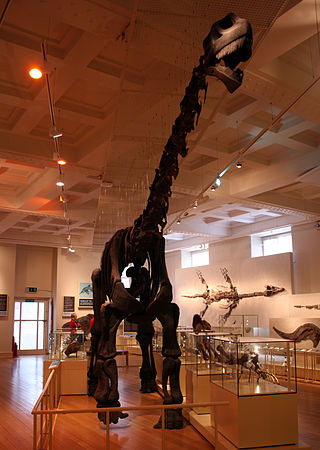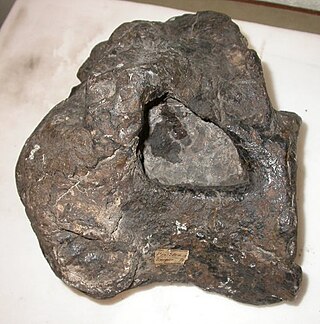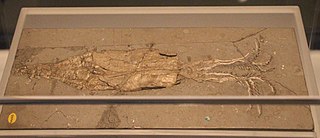Related Research Articles

Dr Thomas Wright FRS FRSE FGS was a Scottish surgeon and palaeontologist.

Thomas Davidson was a British palaeontologist.

John William Salter was an English naturalist, geologist, and palaeontologist.

Cetiosaurus meaning 'whale lizard', from the Greek keteios/κήτειος meaning 'sea monster' and sauros/σαυρος meaning 'lizard', is a genus of herbivorous sauropod dinosaur from the Middle Jurassic Period, living about 168 million years ago in what is now Britain.

Altispinax is a genus of large predatory theropod dinosaur from the Early Cretaceous period of what is now the Wadhurst Clay Formation of East Sussex, England.
Marmarospondylus is a dubious genus of sauropod dinosaur from Middle Jurassic deposits in the English Midlands.

Ornithopsis is a genus of sauropod dinosaur, from the Early Cretaceous of England. The type species, which is the only species seen as valid today, is O. hulkei, which is only known from fragmentary remains, and has been regarded by many authors as dubious.

Nuthetes is the name given to a genus of theropod dinosaur, likely a dromaeosaurid, known only from fossil teeth and jaw fragments found in rocks of the middle Berriasian age in the Cherty Freshwater Member of the Lulworth Formation in England and also the Angeac-Charente bonebed in France. As a dromaeosaurid, Nuthetes would have been a small predator.

Wilfred Hudleston Hudleston FRS was an English geologist, ornithologist and paleontologist.

This is a list of the writings of Charles Darwin.

Belemnotheutis is an extinct coleoid cephalopod genus from the middle and upper Jurassic, related to but morphologically distinct from belemnites. Belemnotheutis fossils are some of the best preserved among coleoids. Remains of soft tissue are well-documented in some specimens, even down to microscopic muscle tissue. In 2008, a group of paleontologists even recovered viable ink from ink sacs found in several specimens.
Leslie Reginald Cox FRS was an English palaeontologist and malacologist.

Eretmosaurus is an extinct genus of plesiosaur.
Leonard Frank Spath FRS was a British geologist specialising in malacology and ammonitology.

Pleurosternon is an extinct genus of freshwater pleurosternid turtle from the latest Jurassic to earliest Cretaceous of Europe. Its type species, P. bullockii was described by the paleontologist Richard Owen in 1853. Since then, and throughout the late 19th century, many fossil turtles were incorrectly assigned to this genus, though only two are currently considered valid.

Pteranodontoidea is an extinct clade of ornithocheiroid pterosaurs from the Early to Late Cretaceous of Asia, Africa, Europe, North America and South America. It was named by Alexander Wilhelm Armin Kellner in 1996. In 2003, Kellner defined the clade as a node-based taxon consisting of the last common ancestor of Anhanguera, Pteranodon and all its descendants. The clade Ornithocheiroidea is sometimes considered to be the senior synonym of Pteranodontoidea, however it depends on its definition. Brian Andres in his analyses, converts Ornithocheiroidea using the definition of Kellner (2003) to avoid this synonymy.

The Charmouth Mudstone Formation is a geological formation in England, dating to the Early Jurassic (Sinemurian–Pliensbachian). It forms part of the lower Lias Group. It is most prominently exposed at its type locality in cliff section between Lyme Regis and Charmouth but onshore it extends northwards to Market Weighton, Yorkshire, and in the subsurface of the East Midlands Shelf and Wessex Basin. The formation is notable for its fossils, including those of ammonites and marine reptiles and rare dinosaur remains. The formation played a prominent role in the history of early paleontology, with its Lyme Regis-Charmouth exposure being frequented by fossil collectors including Mary Anning.
Helen Marguerite Muir-Wood was a British paleontologist and historian of paleontology who spent her career at London's Natural History Museum. She is a recipient of the prestigious Lyell Medal for her contributions to the field.
Hylaeochelys is an extinct genus of plesiochelyid turtle that lived during the Late Jurassic-Early Cretaceous in Portugal, Spain, France, and southern England. The type species was originally named by Richard Owen as Pleurosternon latiscutatum in 1853, before being moved to the new genus Hylaeochelys by Richard Lydekker in 1889. Other species included in the genus are H. belli, H. kappa and H. lata, originally named under different genera by Gideon Mantell and Owen, respectively. All species are represented by carapaces, primarily from the Lulworth Formation of the Purbeck Limestone Group that was deposited during the Berriasian.
References
- ↑ Palaeontographical Society's official website
- ↑ Wood, S.V. 1848. The Crag Mollusca. Part I, Univalves Part 1. Monograph of the Palaeontographical Society London: pp i–xii, 1–208, pls 1–21, (Publ 1, part of Volume 1).
- ↑ "Obituary. Frederick Erasmus Edwards, F.G.S." (PDF). The Geological Magazine. New Series. Decade II. Volume II: 571–572. November 1875.
- ↑ Palaeontographical Society – Research Funding – Details of Awards/Grants
- ↑ Darwin, C. 1851. The fossiI Lepadidae. Monograph of the Palaeontographical Society London: pp. 1-vi. 1–88. pls. i–v (Publ 13, part of Volume 5).
- ↑ Owen, R. 1855. The fossil Reptilia of the Wealden and Purbeck formations. Part 2, Dinosauria. Monograph of the Palaeontographical Society London: pp. 1–54, pls i–xix, xviA. (Publ 27, part of Volume 8).
- ↑ Owen, Richard. 1871. Monograph of the fossil Mammalia of the Mesozoic Formations. Monograph of the Palaeontographical Society London: pp. i–vi, 1–115, pls 1–4. (Issue 110, part of Volume 24)
- ↑ "Biographical Notes on Geological Survey Staff" (PDF). British Geological Survey. Retrieved 23 August 2019.
- ↑ Schindler, M. Arthur Smith Woodward:: His Life and Influence on Modern Vertebrate. p. 44.
- ↑ "Introduction and Bibliography" (PDF). Retrieved 23 August 2019.
- ↑ "Michael Robert House, 1930–2002". The Geological Society. Retrieved 23 August 2019.
- ↑ "Contributor Profiles". Nature. Retrieved 23 August 2019.